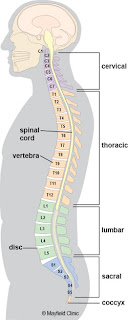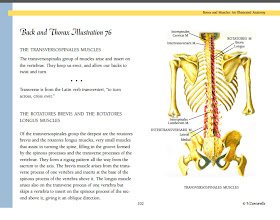Range of motion is generally defined as the amount of movement that a joint or body part can move. We measure range of motion (ROM) by standing in an upright position with your hands at your side, which is 0 degrees. The four movements measured are flexion, extension, lateral flexion and rotation. Flexion is forward bending; extension is bending backward; lateral flexion is side bending; and rotation is a twisting motion.
The Cervical Vertebrae
The cervical part of the spine is made up of seven vertebrae, in which the upper two vertebrae have there own names. The first one, atlas, holds up the skull, and is named after the Greek god who held the heavens upon his shoulders. The second is called the axis, which assists in rotating the head.
The Thoracic Vertebrae
The thoracic spine attaches to our ribcage. Range of motion for the thoracic spine include 30 degrees of rotation and 50 degrees of kyphosis. (Kyphosis is just a name for the outward curve of the thoracic spine).
The Lumbar Vertebrae
The lumbar vertebrae is the largest segment of the spine, helps support the weight of the body, and permit movement. This part of the spine is also one of the most flexible...eh...well maybe more so when done by a contortionist, can you believe this is pretty much all lumbar spine!?
THE TRANSVERSOSPINALES MUSCLES
(Bones and Muscles- An Illustrated Anatomy Virginia Cantarella)
*The multifidus muscle extends and rotates the back. The semispinales muscles; capitis, cervics and thoracacis muscles run over and next to the multifidus muscles. The semispinales muscles extend and rotate the spinal column, and the capitus muscles assist in holding the head erect and turning it.
Range of Motion in the Neck
The neck supports the weight of our heads, is very flexible, and allows us to twist and turn it in all directions.It has two main pivot points, at the base of the neck and at the top where the head sits.
I found this section of an article written on this site: http://www.ncbi.nlm.nih.gov/pmc/articles/PMC1250253/#i1062-6050-40-3-155-b16
to be so informative I felt I should post it here. The citation is can be found at the bottom of this post.
"The cervical spine's range of motion is approximately 80° to 90° of
flexion, 70° of extension, 20° to 45° of lateral flexion, and up to 90°
of rotation to both sides(Swartz)."
"General flexion and extension motion of the neck does not necessarily
reflect the movement among vertebrae in the cervical spine. In fact, a
vertebra may experience its greatest range of motion in flexion or
extension before the cervical column itself has fully flexed or
extended. Furthermore, a vertebra may experience a large range of
movement in one direction while the cervical column on the whole
exhibits movement in the opposite direction(Swartz)."
THE STERNOCLEIDOMASTOID MUSCLE
The sternocledodmastoid muscle assists with the rotation of the head and neck and tilting your chin to each side. There are other muscles that help rotate and bend your neck. Such as the rectus capitis lateralis muscle,and the rectus capitis anterior muscle. These are two small muscles shown in red on the model below.
(Bones and Muscles- An Illustrated Anatomy Virginia Cantarella)
Swartz, Erik E., R.T. Floyd, and Mike Cendoma. Cervical Spine Functional Anatomy and the Biomechanics of Injury Due to Compressive Loading. N.p., July 2005. Web.
http://www.livestrong.com/article/257162-normal-human-range-of-motion/#ixzz2ILzzO1lRWilliams, Brady. "Range of Motion Reference Guide." LIVESTRONG.COM. N.p., 14 June 2011. Web. 30 Dec. 2012.
http://www.youtube.com/watch?v=P26fSK6CGYw
http://www.livestrong.com/article/271802-range-of-motion-reference-guide/
http://www.livestrong.com/article/276514-range-of-motion-of-the-spine/
http://www.livestrong.com/article/95456-normal-neck-range-motion/
http://en.wikipedia.org/wiki/Vertebral_column











what is that move called
ReplyDeleteThanks for sharing, nice post! Post really provice useful information!
ReplyDeleteAn Thái Sơn chia sẻ trẻ sơ sinh nằm nôi điện có tốt không hay võng điện có tốt không và giải đáp cục điện đưa võng giá bao nhiêu cũng như mua máy đưa võng ở tphcm địa chỉ ở đâu uy tín.